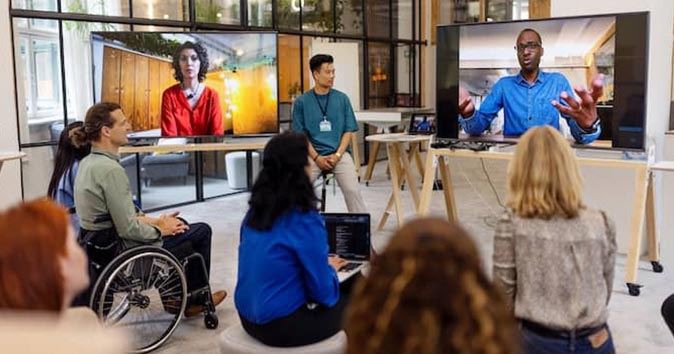Fun Employee Engagement Activities for Every Business in 2025

Without exaggerating, employee engagement influences some of the most important facets of a business. Organizations with engaged employees have significantly higher profitability, less turnover, and less absenteeism. Conversely, disengaged employees are more likely to have frequent absences, make careless mistakes, and be less motivated.
An engaged workforce makes the difference between a company on track to meet its goals, and one left wondering how the year got away from them. Employee engagement is the outcome of prioritizing well-being and connection at work. And employee engagement activities can play a fun, pivotal role in that development.
These activities serve triple duty as a productive way to connect employees, relieve stress, and help the outcomes that affect the business overall.

What is employee engagement?
Employee engagement refers to the extent to which a company's workforce is enthusiastic and involved in their work. In other words, it's your employees' emotional commitment toward their jobs and the organization's overall goals.
Engaged employees believe their efforts make a difference. So, they're more willing to improve their performance and put extra effort into getting things done. Statistics show that organizations with engaged employees report 21% higher profitability Opens in a new tabthan businesses with low engagement levels.
Even better, the positive impact of employee engagement isn't just limited to profitability. It has a myriad of benefits on retention rates, customer satisfaction, and company culture. Engaged employees also show positive signs like the desire to learn and grow and an interest in building relationships with coworkers. Plus, they tend to exceed the expectations of the leaders.
Further reading: 4 Powerful Ways To Fuel Employee Engagement
On the other hand, disengaged employees cost US businesses between $483 to $605 billion every year due to lost productivity, according to a Gallup report.
Benefits of employee engagement activities
It can be challenging for businesses to notice and measure the impact of employee engagement efforts in the short run. That's why some managers might overlook this vital business element. This may explain the high 51% of disengaged and 13% of actively disengaged employees in the US.
Here are five significant benefits you'll reap when implementing an employee engagement strategy:
Higher productivity and efficiency
There's a strong link between employee engagement and their productivity levels. Organizations with engaged employees are 22% more productive than those with disengaged teams. The reason is apparent: engaged employees are more motivated to go out of their way to reach their goals and those of business.
Better employee retention rates
It costs a business 33% of an employee's annual salary to replace them if they resign, according to Employee Benefit News. This is quite costly for companies with high turnover rates.
Employee engagement has a direct impact on retention rates in organizations. Engaged employees are more likely to stay at the company longer, according to Gallup's State of American Workforce report.
The report emphasizes the role of employee engagement in reducing turnover and its high cost to businesses.
The report also notes that when employees feel a robust bond with the organization's purpose and mission, they are more inclined to stay. They can even become brand ambassadors for the company.
Moreover, they'll be willing to establish stronger relationships with customers and co-workers.

Enhanced company culture
Employees who perceive their company's culture positively are 3.8 times more likely to be engaged. That's why setting a strategy to improve employee engagement is only the starting point.
Improving your company culture to allow for implementing these strategies is the most significant part of the process. You'll need to make continuous efforts to improve your company's culture to increase employee engagement. These changes will make a terrific positive difference in the company's culture over time.
Increased customer satisfaction
There's also a strong link between engaged employees and customer satisfaction. When employees are engaged, they're more focused, and they perform better, thus providing higher value and a superior experience for the company's customers.
When you invest in improving employee satisfaction, you indirectly invest in elevating customer satisfaction.
Lower absenteeism level
If you want work to get done, you need people to show up to work. Organizations with engaged employees report a 41% lower absenteeism rate compared to businesses with disengaged workforce, according to Gallup data.
List of fun employee engagement activities for the workplace
There are plenty of ideas for employee engagement you can implement in your business, but always choose activities that perfectly suit your company's and employees' needs.
Here is a list of employee engagement activities and ideas to help you keep your workforce engaged in the workplace:
Workplace parties
Hosting one or two workplace parties a year will help you increase your employee interaction with each other in an informal context. This will improve their relationships and deepen their feeling of belonging to the organization.
The parties you may host can be summer events, ugly sweater parties, Halloween celebrations, or any other occasion your team would appreciate.
Recognition programs
Research has shown that gratitude for employees can profoundly boost engagement and connection. It also helps build resilience, enabling employees to thrive even in stressful times. In addition, an effective recognition program can have a surprising impact on increasing team performance.
Further reading: The ROI of recognition in a time of crisis: how to amplify engagement
The form of recognition you can use includes public thanks, highlighting achievements, or monetary awards. This might entail highlighting positive customer feedback or celebrating a work milestone.
Recognition plans can entail a lot of work, especially in large-scale organizations. Still, they provide terrific benefits. Workhuman® Social Recognition® can save you massive time and effort in organizing and managing your organization's recognition efforts.
Career development programs
Investing in employee development can have a massive impact on increasing their engagement and morale, according to The Wharton School.
It can also help you attract better talent. A recent report from Gallup stated that 68% of job seekers look for employers who provide upskilling and career advancement opportunities. Employees also say they would leave their current companies for better training and opportunities, according to the same report.
Your organization's development programs can include online courses, training, certifications, job rotation, or other techniques that help employees upgrade their skills.
Conferences
Conferences offer you a unique opportunity to bring your team members together to learn, get inspiration, and have a vast room for networking. They're also a great way to discuss the common challenges in the industry and how to overcome them.
Investing in high-value conferences for your employees is an excellent method to engage and develop them. If you're looking for a conference to engage your HR team while providing them with the latest updates on employee engagement and people management topics, check out Workhuman® LiveOpens in a new tab.
At this conference, your team will meet the brightest minds in the industry and be part of the discussion of today's most challenging industry topics. The event brings top-tier speakers dialogue and provides a competitive amount of HR continuing education credits.
Your team will have a chance to attend keynote speeches from leading speakers and participate in various top-notch workshops.
They'll also have a priceless chance to network and interact with thousands of industry peers. Workhuman Live is recognized as one of the ten most innovative conferences in 2022 by BizBashOpens in a new tab.
The conference takes place from April 14th to April 18th in Austin, Texas. It'll discuss a variety of human resources and people management topics, including the following:
- Performance management
- Work culture
- Employee recognition
- Diversity and inclusion
- Building a positive work environment

Learning lunches
Video conferences and emails are good methods for educating your employees about a new policy or specific company changes. However, a more engaging way you can use to deliver the same learning outcomes is to host a light “lunch and learn” session.
A Learning Lunch is a professional event where department employees or even the entire company workforce gather for a meal while having a light learning experience during a work day.
It's a fun activity to build professional skills and discuss important business aspects.
The content you might bring to a learning lunch event varies. Here are some of the most common ideas to inspire you:
- Employee-led workshops
- Discussion of upcoming or recent change
- Product training
- Cross-training
- Diversity conversations
Employee surveys
Employee surveys can provide you with an opportunity to listen to your employees directly. They uncover how people feel about their jobs and the business overall and connect the perceptions of employer and employee.
Surveys make your employees feel heard and allow you to identify the positives and negatives of the organization from employees' perspectives.
You can use employee feedback from the surveys to guide you in taking corrective actions and making adjustments to your strategies. That way, you'll improve engagement and company culture.
Surveying employees becomes even more crucial as more organizations have shifted toward hybrid or remote work models in recent years. Remote workers have a different relationship to the work environment than those in the office, and the goal should be to get them as close as possible.
To ensure that surveying employees will provide you with the most accurate possible data, follow the best practices for employee engagement surveys.
Employee surveys can be extremely impactful when done right. Read this Guide to Employee Engagement Surveys to learn how to craft them.
Welcoming new hires
An employee engagement strategy can start with day one of the employee's experience. One way to do this is to make new hires feel welcome and encourage their workmates to greet and interact with them.
You'll increase their comfort and motivate them to start interacting with the team more quickly. As a result, they'll be more confident to ask about unclear aspects of the job and for any guidance they need.
There are many ways you can welcome new hires. Here are some of the most common ones:
- Introduce them to all the team members individually
- Invite them to the team lunch
- Present them with company merchandise
- Invite an experienced employee to be their temporary mentor
Team building activities
Building strong connections between team members is priceless. According to Forbes, it's one of the most important investments a company should make.
However, it doesn't happen overnight. Establishing strong rapport between employees takes time and requires continuous engagement activities inside and outside the work.
Although all options on this list can work on building connections between employees, team-building activities are the most effective for new teams. You can use these activities when creating a new cross-functional team or welcoming many new employees to a department.
When selecting an engagement activity, the critical point is to consider the whole team's needs and preferences. Choose the one that will be interesting to the majority of members. So, it's a great idea to invite the team to choose the activities themselves.
There are tons of great team-building activities for coworkers. Here are some popular examples:
- Charades
- Connect the Bridges
- Four Question Mingle
- Roses and Thorns
- Escape Room

Happy hours
Employee happy hour is a short gathering where you can bring your team after work for the purpose of socializing and strengthening bonds. This team gathering can take place at any venue and doesn't need to include drinks.
Happy hours are an opportunity for team members to connect outside of work in a casual setting and have fun together. They can boost morale and increase trust and communication between teammates. You can use this activity as a treat after a busy period at work.
It's also worth mentioning that happy hours aren't just exclusive to in-office employees. There are multiple ways you can have a virtual happy hour with your teammates.
Health and Wellness programs
Investing in your employees' health and wellness is a great way to increase engagement. Discounts at local gyms or yoga classes or collaborating with a mindfulness coach to deliver a meditation workshop could be a huge boon to employee well-being.
Paying attention to employees' health and wellness will yield outstanding performance in the long run, both in their personal lives and at work. Nonetheless, make sure to pick a wellness program that fits your employees' needs.
To achieve this, begin this initiative by running an employee interest survey to gain an understanding of the team's preferences regarding health programs.
Employee games
Games can be an excellent opportunity to bring your employees together and boost their engagement. Play allows employees to interact in a better way than in everyday work situations in the office.
Pick an appropriate time and invite your team to an interesting game. You'll be amazed by how this will increase employee engagement at work. There are endless game choices your team may play together. Invite the team to choose the one they find most exciting.
Virtual games and activities
As remote employee engagement can be a bit challenging, you should get creative and take advantage of the virtual infrastructure that allows you to engage and connect with them.
With the right planning, you can increase remote workers' engagement and boost their morale. Today, there's a wide range of virtual employee engagement activities you can use to engage your remote workers.
Host a virtual game night or online activity from one time to another and invite your remote workers to join.
Fundraiser and charity events
Fundraisers and charity days are an excellent opportunity to engage employees for a common cause.
Your company's charity work can take numerous forms, such as a sponsored run or virtual break-off. Regardless of their nature, charitable activities can benefit your employees in multiple ways.
Gathering for a common cause can increase overall engagement and morale in the workplace. A studyOpens in a new tab found a link between acts of generosity and decreased job burnout in the workplace. It also reported a high association between participating in charity work and increased wellness.
People who engaged in regular kindness activities reported feeling in control of their lives and a high level of happiness., according to another study. In addition, these activities can help promote the organization's CSR programs, which makes employees proud of their belonging to the company.

FAQs
How do you start employee engagement activities?
Employee engagement begins with setting a detailed strategy based on your current business and employee needs and situation. Identify clear employee engagement goals you need to achieve within a predefined time frame, then start to pick from the activities mentioned above what will work best to achieve these objectives.
How do you measure employee engagement?
To be able to measure employee engagement, you need to have a clear goal regarding it in the first place.
You should survey employees to understand their perception of the organization and determine how close you are to employee engagement outcomes.
The survey should contain questions about career development, value and recognition, teamwork, trust in leadership, and communication and change management.
Strive to get accurate insights into employee's intent to stay, advocacy, and organizational pride. The data of a well-designed survey will reveal the current state of the engagement within the organization.
An annual employee engagement survey isn't sufficient to get a thorough understanding of the complete picture in the workplace. You need to develop a continuous listening strategy in addition to these annual surveys. Using pulse surveys can be a perfect starting point.
In closing
Employee engagement activities are plentiful, but you should pick the one that most suits your specific company's workforce. Although employee engagement is a long-term initiative that requires time and dedication, it can yield astonishing results for employees and the business.
Hopefully, this guide has provided you with the most effective and fun employee engagement activities you can utilize in your upcoming plans. It's your turn to implement these new learnings to join the 36% of US businesses that reap the benefits of having an engaged workforce.
Further reading: 11 ways employee recognition builds better managers